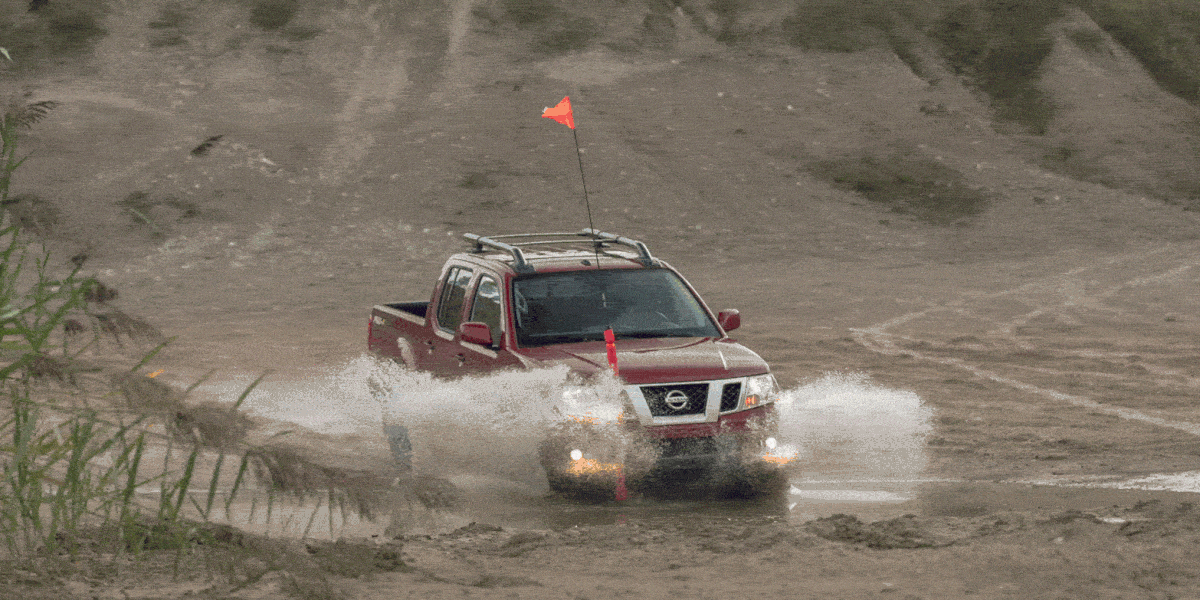
Resto rods are a hot commodity. The recipe is simple: Take a classic and stuff in a newer drivetrain. Do it right and you get a mix of nostalgia and modern performance. Normally, these are custom jobs, big-buck one-offs, but Nissan decided to build a factory resto rod with the 2020 Frontier.
Introduced in 2004 for the 2005 model year, the Frontier is the mid-size truck that time—and Nissan—forgot. But its naturally aspirated 310-horsepower 3.8-liter V-6 and nine-speed automatic transmission belong to the redesigned 2022 Nissan Frontier. Why the swap? The simple answer is that engine and transmission are ready for the next-generation truck, but the rest of the pickup isn’t quite baked. Hence, the 2020 Frontier, where an old design provides a sneak preview of coming attractions.
Last year’s 4.0-liter V-6 made 261 horsepower and 281 pound-feet of torque. The new VQ38 hits the same torque number at slightly higher rpm (4400 rpm, compared to 4000) but delivers 49 additional horsepower and improved EPA numbers, with four-wheel-drive models enjoying a bump from 17 mpg to 19 mpg combined. The V-6 embraces the usual modern tech: variable-valve timing, direct fuel-injection, and a variable-displacement oil pump. And it’s true that Nissan can claim best-in-class horsepower but not by much. The Chevrolet Colorado‘s V-6 makes 308 horsepower. You’d think that if you’re designing a whole new engine, you’d try to destroy the benchmark rather than gently nudge it aside, but Nissan’s priority seems to be fuel economy rather than brute power.
The 3.8-liter bolts up to a nine-speed transmission—the manual transmissions are gone, along with the four-cylinder models—which nearly doubles the ratio spread of the old five-speed auto. The new transmission is also quieter, by virtue of a centrifugal pendulum absorber. Congratulations, you now have a fun conversation starter at your next cocktail party! The torque converter locks up more often.
But whatever EPA fuel-economy gains are bestowed by the new engine and transmission, they didn’t show up on our 75-mph highway test, where our 2020 Frontier Pro-4X managed 20 mpg—exactly the same as the last Frontier Pro-4X we tested, a 2017 model. Our observed economy, 15 mpg, was 1 mpg worse than the 2017 truck managed, although these days we might be doing more city driving. But unless your daily drive mimics an EPA test cycle, it doesn’t look like the new engine and transmission deliver any practical efficiency gains. Apparently, there’s no magic formula for pushing this particular haybarn down the highway.
The fresh powertrain didn’t much matter at the test track, either. Despite its extra horsepower and four additional forward gears, the 2020 Frontier was exactly zero percent quicker than the 2017 to 60 mph, posting an identical 7.3-second time. The extra power is apparent in the quarter-mile, where the new truck’s 15.6-second run at 90 mph bests the 2017’s 15.8 seconds at 87 mph. Thanks to a widely inaccurate speedometer, the updated Frontier also outran the old powertrain on top speed, hitting an enervating 120 mph, a 7-mph gain. So, there’s that. But outside of the high-speed edge cases, the new powertrain merely paces the previous one. At least the 3.8-liter does seem notably smoother and quieter than the Nickelback-era 4.0-liter.
The Frontier’s chassis, ancient as it is, doesn’t feel particularly outdated, given that the basic architecture of midsize pickups hasn’t much changed since the Frontier’s introduction. All of its more modern rivals—the Chevy Colorado, Toyota Tacoma, and Ford Ranger—use body-on-frame construction with a leaf-sprung solid axle out back and independent front suspension, just like Ye Olde Frontier. The advances, over the years, pertain to propulsion and interiors, and that latter area is where the Pro-4X really shows its age.
The Frontier’s cabin is a fly in amber that has flawlessly preserved Nissan’s early-2000s cost-cutting strategy. The four-wheel-drive indicator light is an orange-backlit LED icon with all the graphic sophistication of a Tamagotchi. The USB port looks like the kind of 12-volt add-on you’d buy at a seedy truck stop to charge your vape pen. Push-button start is now standard, but the old ignition slot by the steering wheel is still there, covered with a scab of plastic. And the heated front seats are comfortable enough, but adults confined to the cramped, upright back seat will wonder how they’ve wronged you. Then again, when this truck was designed, human beings were smaller.
If, at this point, you’re wondering why Nissan let the Frontier hang around like a pair of cargo pants at the back of your closet, it’s because plenty of people still want cargo pants. Nissan has sold more than a million examples of this generation (and counting), benefiting from the brand’s reputation for quality and the years in the 2010s when Ford and General Motors didn’t offer a mid-size truck. But now the competition is fierce, and the main argument for the Frontier is an economic one—at $38,745 as tested, it’s about $4,000 cheaper than a non-ZR2 Chevy Colorado with similar off-road equipment.
Despite the new guts, this final Frontier doesn’t feel much different than the one that debuted 16 years ago, when respected cyclist Lance Armstrong was winning hearts and the Tour de France, and you could trade in your off-lease Oldsmobile for a nice new Mercury. As much as we like resto rods, you might want to wait for the rest of it.
This content is created and maintained by a third party, and imported onto this page to help users provide their email addresses. You may be able to find more information about this and similar content at piano.io
